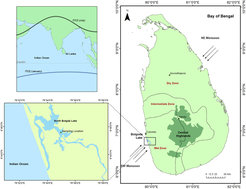A New Holocene Climate and Environmental Record for Sri Lanka
New lake records track changes in Indian Ocean Monsoon, showing changing precipitation across 3,000 years

Changes in the circulation of the seasonal Indian Ocean Monsoon over South Asia cause devastating floods and droughts, which are increasing across what is one of the most densely populated parts of the world. Past records of changes in this climate system are key to better predicting its behaviour, as well as its impact on local environments across South Asia. However, such records are lacking, particularly for Sri Lanka, where natural lakes that so often provide well-dated archives of past changes in rainfall and precipitation are in short supply.
In a new study, published in the Journal of Quaternary Science, a multidisciplinary, international, team, including members of the Department of Archaeology from MPI-SHH, present a new, well-dated lake record found close to the Sri Lankan capital of Colombo. The application of multiple scientific methods, including pollen and biomarker analysis, show fluctuating precipitation in the region across the past 3,000 years. The team argue that changes in rainfall may have had a major impact on the distribution of ancient urbanism in the region, and provide important insights into the impacts of the Indian Ocean Monsoon at the center of its modern range.
